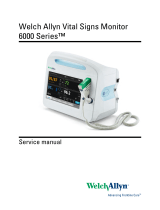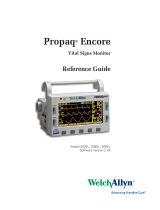
ii Welch Allyn Vital Signs Monitor 300 Series
© 2011 Welch Allyn. All rights are reserved. To support the intended use of the product described in this publication, the
purchaser of the product is permitted to copy this publication, for internal distribution only, from the media provided by Welch
Allyn. No other use, reproduction, or distribution of this publication, or any part of it, is permitted without written permission
from Welch Allyn. Welch Allyn assumes no responsibility for any injury to anyone, or for any illegal or improper use of the
product, that may result from failure to use this product in accordance with the instructions, cautions, warnings, or statement
of intended use published in this manual.
Welch Allyn and Flexible Monitoring are registered trademarks of Welch Allyn. POEM and FlexNet are trademarks of Welch
Allyn.
Nellcor and Oximax are registered trademarks of Nellcor Puritan Bennett.
SET, LNCS, and Masimo are registered trademarks of Masimo Corporation. Possession or purchase of a Masimo SpO
2
-
equipped monitor does not convey any express or implied license to use the device with unauthorized sensors or cables
which would, alone or in combination with this device, fall within the scope of one or more of the patents relating to this
device.
Software in this product is copyright by Welch Allyn or its vendors. All rights are reserved. The software is protected by
United States of America copyright laws and international treaty provisions applicable worldwide. Under such laws, the
licensee is entitled to use the copy of the software incorporated with this instrument as intended in the operation of the
product in which it is embedded. The software may not be copied, decompiled, reverse-engineered, disassembled or
otherwise reduced to human-perceivable form. This is not a sale of the software or any copy of the software; all right, title
and ownership of the software remain with Welch Allyn or its vendors.
For information about any Welch Allyn product, call Welch Allyn Technical Support:
This device complies with Part 15 of the FCC rules and with the rules of the Canadian ICES-003. Operation is subject to the
following two conditions: (1) This device may not cause harmful interference and (2) this device must accept any interference
received, including interference that may cause undesired operation.
Caution! Changes or modifications not expressly approved by Welch Allyn could void the purchaser’s authority to operate
the equipment.
810-2811-02 (CD)
Manual Part Number 810-1651-04 Rev A, 09/2011
www.welchallyn.com
Printed in USA
USA + 1 315 685 4560
800 535 6663
Australia + 61 2 9638 3000
Canada 800 561 8797 China + 86 216 327 9631
European Call Center + 35 3 46 906 7790 France + 33 1 55 69 58 49
Germany + 49 7477 92 71 86 Japan +81 42 703 6084
Latin America + 1 305 669 9003 Netherlands + 31 202 061 360
Singapore + 65 6419 8100 South Africa + 27 11 777 7555
United Kingdom + 44 20 7365 6780 Sweden + 46 8 58 53 65 51
Welch Allyn, Inc.
8500 SW Creekside Plac
Beaverton, OR 97008-7107 USA
Regulatory Affairs Representative
Welch Allyn Limited
Navan Business Park
Dublin Road, Navan
County Meath, Republic of Ireland




































